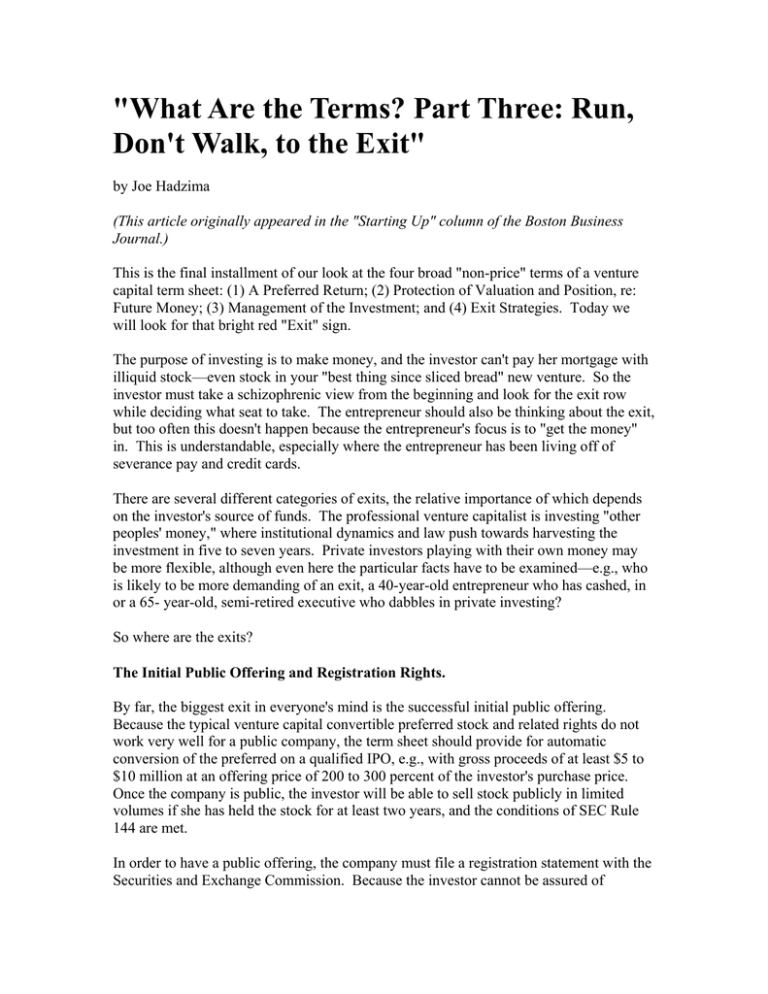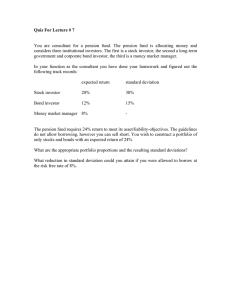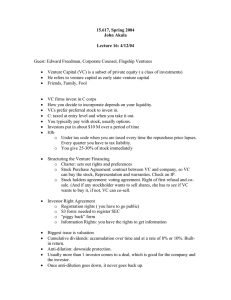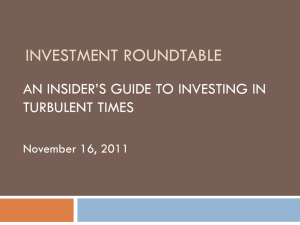"What Are the Terms? Part Three: Run,
advertisement

"What Are the Terms? Part Three: Run, Don't Walk, to the Exit" by Joe Hadzima (This article originally appeared in the "Starting Up" column of the Boston Business Journal.) This is the final installment of our look at the four broad "non-price" terms of a venture capital term sheet: (1) A Preferred Return; (2) Protection of Valuation and Position, re: Future Money; (3) Management of the Investment; and (4) Exit Strategies. Today we will look for that bright red "Exit" sign. The purpose of investing is to make money, and the investor can't pay her mortgage with illiquid stock—even stock in your "best thing since sliced bread" new venture. So the investor must take a schizophrenic view from the beginning and look for the exit row while deciding what seat to take. The entrepreneur should also be thinking about the exit, but too often this doesn't happen because the entrepreneur's focus is to "get the money" in. This is understandable, especially where the entrepreneur has been living off of severance pay and credit cards. There are several different categories of exits, the relative importance of which depends on the investor's source of funds. The professional venture capitalist is investing "other peoples' money," where institutional dynamics and law push towards harvesting the investment in five to seven years. Private investors playing with their own money may be more flexible, although even here the particular facts have to be examined—e.g., who is likely to be more demanding of an exit, a 40-year-old entrepreneur who has cashed, in or a 65- year-old, semi-retired executive who dabbles in private investing? So where are the exits? The Initial Public Offering and Registration Rights. By far, the biggest exit in everyone's mind is the successful initial public offering. Because the typical venture capital convertible preferred stock and related rights do not work very well for a public company, the term sheet should provide for automatic conversion of the preferred on a qualified IPO, e.g., with gross proceeds of at least $5 to $10 million at an offering price of 200 to 300 percent of the investor's purchase price. Once the company is public, the investor will be able to sell stock publicly in limited volumes if she has held the stock for at least two years, and the conditions of SEC Rule 144 are met. In order to have a public offering, the company must file a registration statement with the Securities and Exchange Commission. Because the investor cannot be assured of controlling the Board of Directors of the company (after all, that is what the entrepreneur fears will happen), the investor usually negotiates for "demand registration rights" under which the company contractually agrees to file a registration statement on the demand of the investor. The number of "demands" is negotiated, with the company saying that one is enough and the investor arguing for two or more. Conceptually, the granting of demand registration rights is a big deal for the company because of the time and cost involved if those rights are invoked—it can easily cost $200,000 or more to file a registration statement. In reality, it is a rare case when registration is demanded against the desires of management—after all management has to go on the "road show" and make a good presentation to the mutual fund managers and brokers who will be buying the stock. In addition, the investor usually receives "piggyback" registration rights under which the investor's shares are included in any "primary registration" statement (where the company is selling its own stock), or in any "secondary registration" (where the company is filing a registration statement to permit others to sell). Sale/Acquisition of the Company. Another exit is the sale or acquisition of the company. Such an event is usually defined to constitute a "liquidation" for purposes of the investor's liquidation preference. Although it is not usual for the investors to have the right to require the company to be sold (unless they own enough stock to do this on their own), the separate vote of the investors is typically required in order to approve the deal. This blocking right helps, among other things, to protect against "sweetheart" deals in which management get big employment contracts and stock options in the new company in lieu of a good price for the stock. Mandatory Redemption. While going public or an acquisition usually connote a clear "success," the investor must also consider the case in which the company only achieves moderate success and management is content to keep things going as a private company. The investor may negotiate a mandatory redemption at the investor's election, meaning that the investor can say "enough is enough, buy my stock." The redemption price is typically the liquidation preference including accrued dividends, but in some cases I have seen a multiple of the liquidation preference or some notion of fair market value. The redemption right would normally not apply until five to seven years from the initial investment date. It is likely that a growing company will not have the cash in the bank to meet the redemption. As a result, the mandatory redemption has the effect of forcing a sale of the company or some of its assets. It is here where I have seen the most bitter fights in which the investors have lost confidence in the entrepreneur and want to get their money out while the entrepreneur, believing that a newly adopted business strategy will work, finds that the company is being pulled out from under him, with the result that he has little, if anything, to show for his years of work. This same dynamic can occur where the company has achieved good results, but the entrepreneur sees an even bigger success in the future, while the investor, who gets first dollars out via the liquidation preference, says a "bird in the hand is worth two in the bush." Picture a scenario in which Bill Gates took on venture investors who decided that Microsoft should be sold in 1984 and you'll get the picture. Run, Don't Walk. The entrepreneur may be able to negotiate some of these issues to his or her advantage, but when all is said and done, it must be recognized that when you take in other people's money, you have to be willing to deliver on their time schedule. So, as an entrepreneur in this situation, plan for success and then "run, don't walk" your business towards an orderly exit. DISCLAIMER: This column is designed to give the reader an overview of a topic and is not intended to constitute legal advice as to any particular fact situation. In addition, laws and their interpretations change over time and the contents of this column may not reflect these changes. The reader is advised to consult competent legal counsel as to his or her particular situation.






